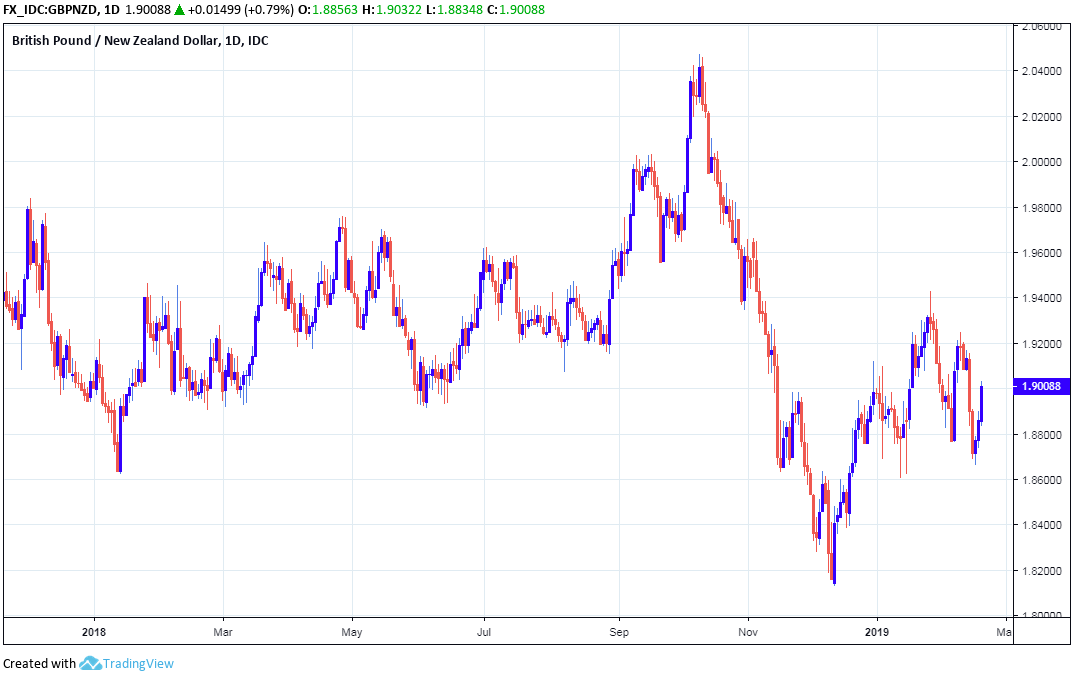The New Zealand Dollar Outlook is "Solid" says ASB
- Written by: James Skinner
 © Natanael Ginting, Adobe Stock
© Natanael Ginting, Adobe Stock
- NZD to hold, then extend recent gains says ASB Bank.
- As Kiwi economic outlook solid, but global economy a risk.
- RBNZ to avoid interest rate cut this year, then hike in 2020.
The New Zealand Dollar will hold onto its recent gains during the quarters ahead, according to analysts at ASB Bank, who say the outlook for the Kiwi itself is solid but that the global economy poses a threat to the currency.
Global economic growth is slowing already but if the outlook were to deteriorate even further then New Zealand's small and open economy would likely demand that the currency depreciate further, ASB says. But so long as that doesn't happen the Antipodean unit has a neat and steady path laid out ahead of it.
"We expect the NZD to strengthen, given the well-performing New Zealand economy, upgrade to New Zealand’s sovereign outlook by selected international credit rating agencies, persistently high New Zealand terms of trade, and the continued investor interest in New Zealand assets," says Nick Tuffley, chief economist at ASB, a subsidiary of Commonwealth Bank of Australia.
The Kiwi is the best performing G10 currency this February after shooting to the top of the league table last week when the Reserve Bank of New Zealand (RBNZ) took the market by surprise in reiterating its neutral interest rate stance.
Consensus had been for the RBNZ to warn again that a rate cut could be in the pipeline for the months ahead, given a slowdown in the economy during the second half of 2018 and a deterioration in the outlook for global growth going into the New Year.
RBNZ Governor Adrian Orr said on the day the next move in rates could be either up or down and in its graphic projections of long-term Kiwi interest rates, it nudged further out by six months the point at which it currently sees itself raising the cash rate from its current record low of 1.75%.
The Kiwi has risen by more than 1% against the Pound, U.S. Dollar and Canadian Dollar this month, with most of the gains coming since last week's announcement. And the currency has risen more than 2% against the Aussie, Euro and other European units.

Above: Pound-to-New-Zealand-Dollar rate shown at daily intervals.
"We had earlier changed our OCR call and shaded down our NZD interest rate forecasts, in light of global developments, our low inflation outlook and higher proposed bank capital requirements for locally-incorporated NZ banks. We now expect the OCR to remain on hold until February 2021 (previously August 2020). We also expect a historically-low OCR endpoint of just 2.25% this cycle," says Tuffley.
ASB forecasts that New Zealand's quarterly GDP growth rate likely picked up from 0.3% to 0.5% in the final quarter of 2018 and that it will rise further, to 0.8%, during the first quarter of 2019. That would take pressure off the RBNZ.
Kiwi growth fell to its weakest level for three years during the third-quarter of last year, while most economies across the world appear to have slowed during the final quarter, although New Zealand's outstanding GDP number will not be released until March 20.
The number of unemployed also rose a full 9% in the final quarter of 2018, pushing the unemployment rate up by 30 basis points to 4.3%, suggesting the final months of the year may have been ugly for the Kiwi economy too.
"The published RBNZ projections did show a weaker short-term inflation outlook, with OCR increases being pushed out by six months and with a 20bp lower endpoint relative to November. This was similar in spirit to our published interest rate view," Tuffley says.
The RBNZ has been battling below-target inflation for a number of years, leading the bank to hold its interest rate at a record low since late 2016, but a slowing economy is now making its job of returning the consumer price index to the upper band of the 1%-to-3% target all the more difficult.

Above: NZD/USD rate shown at daily intervals.
Financial markets had in 2018 begun betting the RBNZ would cut its cash rate before the curtain closes on 2019, which weighed heavily on the Kiwi currency. The overnight-index-swap-implied rate for February 2020 was just 1.54% before the RBNZ announcement on the 11th, but it's risen back to 1.64% since then.
That means the market still thinks there's a hefty chance of a rate cut coming inside the next year, although the implied probability is down from around 80% before the RBNZ spoke, to a little under 50%.
ASB says the RBNZ will not cut its interest rate, and will instead wait until some time next year before lifting it to 2%. If this proves correct then its gradual realisation by the market could provide a powerful tailwind to the New Zealand Dollar over the coming months. This is effectively what ASB is forecasting.
Tuffley and the ASB team project the NZD/USD rate will rise from 0.68 Tuesday to 0.69 before the end of 2019 and 0.71 by December 2020. The Pound-to-New-Zealand-Dollar rate is seen falling from to 1.90 Tuesday to 1.85 by year-end and 1.81 before December 2020.
Time to move your money? Get 3-5% more currency than your bank would offer by using the services of foreign exchange specialists at RationalFX. A specialist broker can deliver you an exchange rate closer to the real market rate, thereby saving you substantial quantities of currency. Find out more here.
* Advertisement




